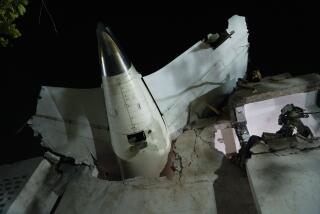Transcript Reveals Doomed Pilots Felt a Problem Early
- Share via
WASHINGTON — The captain of a commuter plane that crashed in January knew she was in deadly serious trouble almost immediately after taking off from Charlotte, N.C., according to a transcript of the flight’s last moments released Tuesday.
The crash of U.S. Airways Express Flight 5481 already has forced the Federal Aviation Administration to revise safety rules affecting small planes. National Transportation Safety Board hearings that opened Tuesday are focusing on the accuracy of weight estimates, the rigor of maintenance procedures and the role of outside contractors in servicing aircraft.
“Help me!” Capt. Katie Leslie, 25, called to her co-pilot as the twin-engine turboprop climbed at an unnaturally steep angle.
“Push down!” responded first officer Jonathan Gibbs, 27, according to a transcript of the plane’s cockpit voice recorder.
Their frantic efforts were of no use. In the passenger cabin someone -- perhaps the plane’s youngest passenger, a 12-year-old girl -- cried out “Daddy!” Automatic stall alarms sounded in the cockpit as the Beech 1900D plunged into an airport hangar and exploded in flames, killing the two pilots and all 19 passengers.
The Jan. 8 flight was operated for U.S. Airways Express by Air Midwest, part of Phoenix-based Mesa Air Group. Airline officials have said they are cooperating with the investigation.
No conclusion about what caused the crash is expected for months, but lead NTSB investigator Lorenda Ward said the answer is likely to be found in the combination of a plane loaded beyond its limits and maintenance that may have inadvertently limited the pilots’ options to regain control.
The crash has prompted skepticism about the FAA’s claim that all airline service -- whether on a Boeing 747 or a propeller plane -- must meet the same high safety standards.
“If 5 pounds here or 10 pounds there can make a difference, that tells me that the safety margin built into these [commuter] planes has to be smaller,” said Kevin Mitchell, head of the Business Travel Coalition.
Investigators have determined that the plane that crashed weighed a minimum of 17,400 pounds at takeoff, Ward said, or at least 280 pounds above its allowable maximum takeoff weight of 17,120 pounds.
The plane was also loaded in a manner that made it more tail-heavy than specified by its manufacturer, Ward said.
The pilots had estimated the weight at 17,018 pounds, just barely under the limit. But they relied partly on FAA-approved weight estimates for passengers that have been revised upward since the accident to account for Americans’ increasing girth.
The plane should have flown even if overloaded, said Terry McVenes, a pilot and safety vice chairman for the Air Line Pilots Assn.
“If [the controls] would have been rigged normally, it probably would have flown just fine,” McVenes said.
Flight controls called elevators determine the up-and-down pitch of a plane’s nose. Movable flaps in the horizontal part of a plane’s tail, the elevators are operated by a pilot pulling back or pushing forward on the control column.
But Ward testified that maintenance on the night of Jan. 6 altered the relationship between the control column and the elevators. A pilot pushing forward on the control column would not be able to get the elevators to go all the way down, she said.
“There was a change in the control column position during maintenance and ... the airplane lost about two-thirds of its down elevator capability,” Ward said. Seconds before the crash, the pilots were pushing on the controls to lower the plane’s nose.
An NTSB report said the mechanics who performed the work at a maintenance facility in West Virginia checked after they finished to make sure the elevators were able to move across their full up-and-down range. But they tested only the back end of the system -- the elevators -- and “never verified the movement at the control column” in the front end, the report said.
Mechanics adjusted cables that link the cockpit controls and the elevators after finding some slack. But two control cables that are normally the same length were adjusted so that one was about 1.8 inches longer than the other.
Investigators are still analyzing the exact repercussions of the maintenance. Among the issues is whether proper procedures were followed. The plane then apparently flew without any problems on eight flights before the crash.
Also under scrutiny is Air Midwest’s arrangements for contracting out maintenance, a common practice in the industry. The airline contracts with Raytheon Aerospace to provide maintenance, and Raytheon in turn contracts with an employment service for mechanics.
The Florida-based employment service, Structural Modification and Repair Technicians, or SMART Inc., has been in business for 14 years and has supplied mechanics for Air Force One, testified recruitment director Thomas Wellcome. But he acknowledged that the company does not routinely conduct face-to-face interviews of prospective mechanics.
“It doesn’t take a rocket scientist to see that you could beat that system pretty easily,” said NTSB board member John Goglia.
More to Read
Sign up for Essential California
The most important California stories and recommendations in your inbox every morning.
You may occasionally receive promotional content from the Los Angeles Times.












